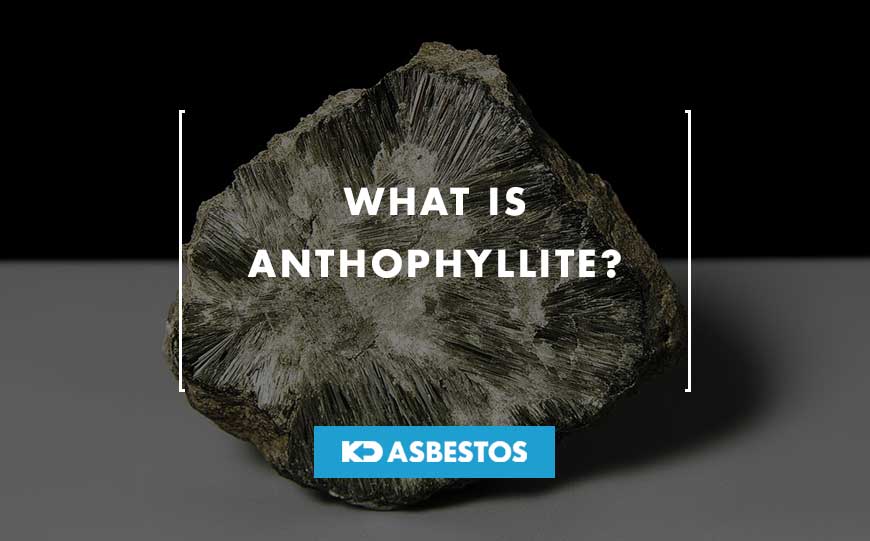
Most people have never heard of anthophyllite, yet this uncommon mineral has played a significant role in both geology and public health concerns.
Found deep within metamorphic rocks where intense heat and pressure create the perfect conditions for its formation, anthophyllite develops its characteristic fibrous structure from a combination of magnesium and iron silicate.
What makes this mineral particularly noteworthy is its classification as one of the six recognised types of asbestos.
While it’s far less common than its notorious cousins like chrysotile or amosite, anthophyllite still poses serious health risks that professionals in our industry need to understand.
Whether you’re dealing with older buildings, conducting environmental assessments, or simply want to expand your knowledge of hazardous materials, getting familiar with anthophyllite’s properties and dangers is crucial.
We’ll walk through everything from spotting it in the field to understanding why it ended up on construction sites, plus the health risks that make proper identification and handling so important.
Table of Contents
What is Anthophyllite?
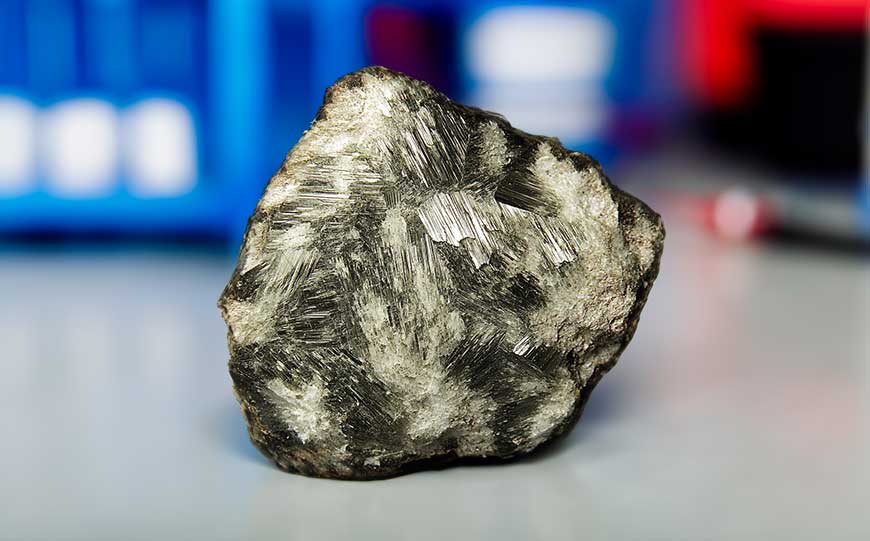
Think of anthophyllite as geology’s less famous troublemaker.
This mineral forms when existing rocks get subjected to extreme conditions deep in the Earth’s crust.
The intense heat and pressure literally reshape the rock’s structure, creating something entirely different from what was there before.
The science behind it is straightforward enough.
Anthophyllite’s makeup centers around magnesium and iron silicate, with the chemical formula (Mg,Fe)7Si8O22(OH)2.
But what really matters for our work is how this mineral behaves in the real world.
You’ll rarely find anthophyllite sitting alone.
It tends to show up alongside other minerals that form under similar harsh conditions.
Talc is a frequent companion, along with pyroxene and biotite.
This mineral association actually helps geologists identify potential anthophyllite deposits.
The key characteristic that puts anthophyllite on our radar is its fibrous nature.
Those tiny, needle-like fibres place it squarely in the asbestos family, making it a legitimate health concern despite being much rarer than the asbestos types most people know about.
While it might not grab headlines like chrysotile, anthophyllite can be just as dangerous when disturbed and becomes airborne.
What Does Anthophyllite Look Like?
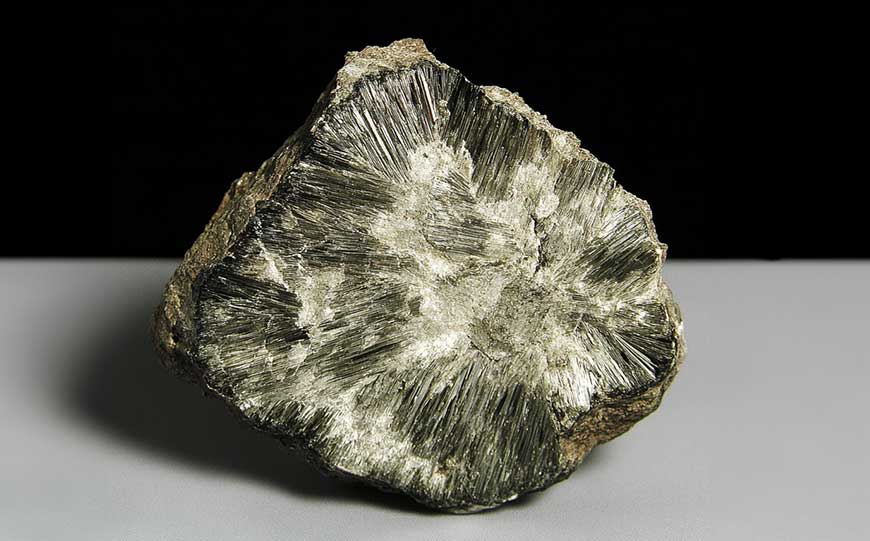
Spotting anthophyllite isn’t always straightforward, but there are telltale signs that experienced professionals learn to recognise.
The mineral usually shows up in shades of brown, green, or grey, though the exact colour depends on the iron content and other trace elements present during formation.
What really sets anthophyllite apart is its texture.
Run your fingers over a sample and you’ll notice that distinctive fibrous feel.
Some specimens have an almost woolly appearance, while others look more silky or smooth.
This isn’t just a cosmetic detail; that fibrous structure is exactly what makes the mineral hazardous.
The surface finish varies quite a bit from sample to sample.
You might encounter pieces with a bright, almost metallic shine, while others appear completely dull and unremarkable.
Much of this comes down to how the mineral formed and whether it’s been weathered or altered over time.
One reliable identification feature is how anthophyllite breaks.
Instead of cracking randomly like most rocks, it splits cleanly along those fibre lines.
This cleavage pattern is actually quite useful for field identification, though you obviously want to handle any suspected asbestos material with appropriate precautions.
At 5 to 6 on the Mohs hardness scale, anthophyllite sits somewhere between a steel file and quartz in terms of durability.
When properly polished, it can develop an attractive glassy or pearl-like shine, which explains why it occasionally found its way into decorative applications before we understood the health risks.
What was Anthophyllite Used For?
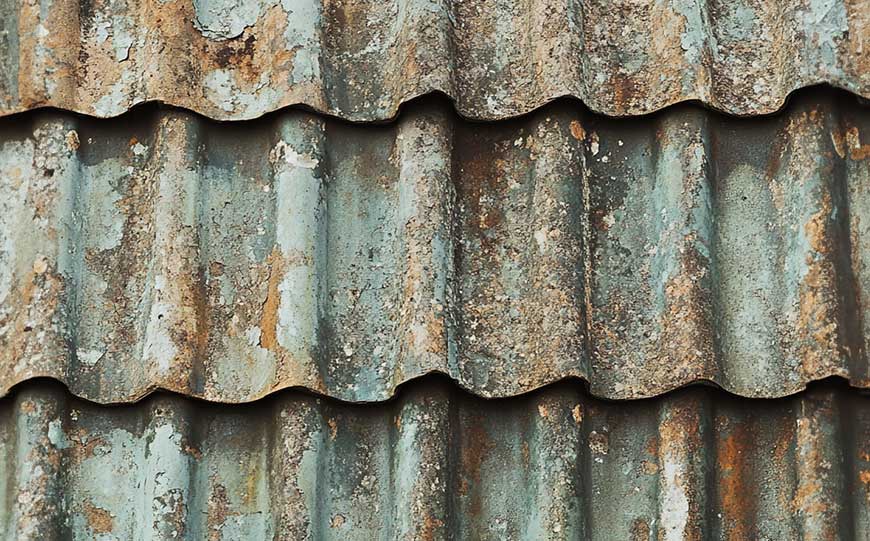
While anthophyllite never reached the widespread use of other asbestos types, it still found its way into various applications throughout the 20th century.
Its natural resistance to heat and that characteristic fibrous structure made it attractive to manufacturers looking for affordable insulation solutions.
Industrial Applications
The construction and manufacturing industries discovered anthophyllite’s potential relatively early on.
Its ability to withstand high temperatures without breaking down made it a logical choice for insulating pipes, boilers, and other equipment that generated significant heat.
You’d find it mixed into insulation materials for both residential and commercial buildings, often combined with other asbestos fibres to create products that seemed perfect for the job.
Industrial facilities particularly valued anthophyllite for protecting workers and equipment from extreme temperatures.
Steam pipes, furnace linings, and various heat-resistant gaskets all benefited from its thermal properties.
The mineral’s durability meant these applications could last for decades without replacement, which seemed like a major advantage at the time.
What made anthophyllite especially appealing to manufacturers was its workability.
Unlike some minerals that are difficult to process, anthophyllite could be woven into fabrics, mixed into cement products, or formed into sheets and boards.
This versatility opened doors to numerous specialised applications across different industries, from shipbuilding to power generation.
Construction Materials
The construction industry embraced anthophyllite for projects where fire safety was a primary concern.
Builders mixed it into roofing shingles and tiles, creating products that could better withstand sparks and flames.
This seemed particularly valuable for commercial buildings and industrial facilities where fire hazards were an everyday reality.
Flooring applications became another common use, especially in areas exposed to high heat or heavy wear.
Anthophyllite-containing vinyl tiles and linoleum offered both durability and fire resistance, making them popular choices for schools, hospitals, and office buildings throughout the mid-1900s.
Plaster manufacturers discovered they could improve their products significantly by adding anthophyllite fibres.
The mineral helped prevent cracking while boosting the plaster’s ability to resist heat damage.
This made it especially useful for walls near furnaces, fireplaces, and industrial equipment.
Perhaps most concerning from today’s perspective was its use in protective coatings and sealants.
These products often required workers to spray or brush anthophyllite-containing materials in confined spaces, creating exactly the conditions that lead to dangerous fibre exposure.
What seemed like smart engineering at the time turned into a serious occupational health hazard that we’re still dealing with decades later.
Automotive Uses
Car manufacturers turned to anthophyllite for components that faced serious heat stress.
Brake linings were a natural fit since they needed to handle the intense friction and temperatures generated during stopping.
The mineral’s heat resistance meant brakes could perform consistently without degrading under normal driving conditions.
Gaskets represented another key application, particularly in engine compartments where temperatures regularly exceeded what many materials could handle.
Anthophyllite helped create seals that wouldn’t fail when exposed to hot oil, coolant, or exhaust gases.
The automotive industry valued anthophyllite because it delivered reliable performance in demanding conditions.
Unfortunately, mechanics working on these vehicles often had no idea they were being exposed to asbestos fibres during routine brake jobs and engine repairs.
Mineral Collectors and Geologists
Anthophyllite attracts collectors precisely because it’s uncommon and visually distinctive.
Those fibrous crystals and varied colours make for interesting display pieces, especially when found alongside other metamorphic minerals.
Geologists value anthophyllite specimens for research and educational purposes.
The mineral helps tell the story of how rocks transform under extreme conditions, making it useful for understanding metamorphic processes and regional geology.
Of course, modern collectors handle these specimens with appropriate safety measures, recognising the health risks that come with any asbestos mineral.
Where is Anthophyllite Found?
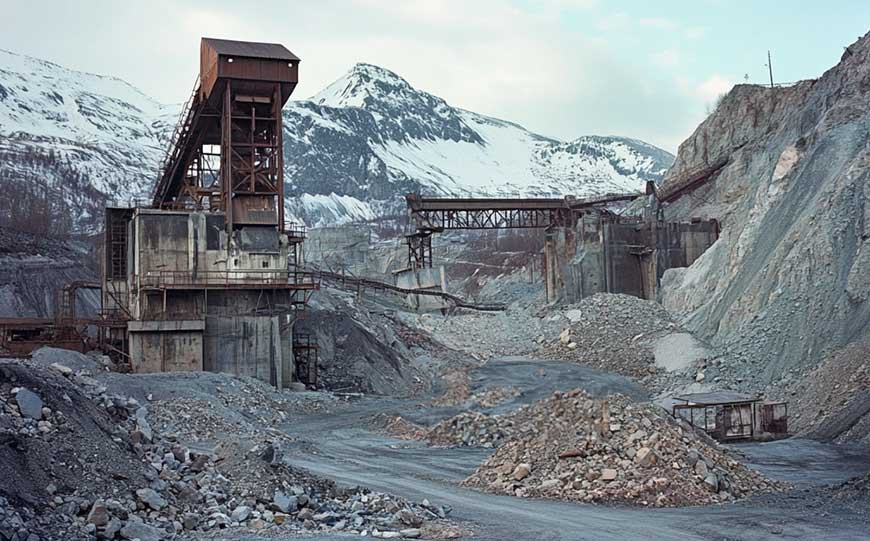
Anthophyllite shows up in metamorphic rock formations where intense heat and pressure have transformed the original rock structure.
These geological conditions create the perfect environment for anthophyllite to develop, making it a reliable indicator of the extreme forces that shaped the area.
When geologists find anthophyllite, they know they’re looking at rocks that experienced significant metamorphic events.
The mineral essentially acts as a geological fingerprint, revealing the temperature and pressure conditions that existed during formation.
Several regions worldwide host notable anthophyllite deposits, each with their own geological story to tell.
USA
Vermont and North Carolina stand out as the primary anthophyllite locations in America.
Both states host deposits within ultramafic rocks transformed through metamorphic processes, creating ideal conditions for anthophyllite formation.
These magnesium and iron-rich rock formations provided the raw materials needed for anthophyllite development.
Vermont’s deposits have been particularly well-studied, while North Carolina’s occurrences have attracted both researchers and commercial interest over the years.
Both locations continue to serve as important reference sites for understanding how anthophyllite forms in North American geology.
Finland
Finland hosts some of the world’s most significant anthophyllite deposits, particularly within ancient Precambrian rock formations.
These deposits formed billions of years ago during early Earth’s intense geological activity.
The Finnish occurrences provide valuable insights into how metamorphic processes worked during Earth’s early history.
Researchers study these ancient formations to better understand both regional geology and the conditions that favor anthophyllite development.
Finland’s deposits have also contributed to commercial anthophyllite production, making the country an important player in the global asbestos industry.
Australia
Australia’s anthophyllite deposits occur primarily in gneiss and schist formations, classic metamorphic rock types that form under intense geological stress.
These environments create the complex mineral assemblages where anthophyllite develops alongside other metamorphic minerals.
The varied geological settings across Australia have produced anthophyllite in different contexts, helping researchers understand how local conditions influence the mineral’s formation and characteristics.
These Australian occurrences add to the global picture of anthophyllite distribution and formation processes.
Mineral Associations
Anthophyllite rarely appears alone.
It typically forms alongside talc, pyroxene, and biotite, creating mineral assemblages that tell the story of the rock’s metamorphic journey.
These companion minerals formed under similar temperature and pressure conditions, making them reliable indicators of the geological processes at work.
When geologists find this particular combination, they can reconstruct the metamorphic history of the area.
These mineral relationships also help with field identification and provide clues about the regional geology and crustal evolution in different parts of the world.
How to Identify Anthophyllite Asbestos

Proper identification of anthophyllite requires specialised techniques since it shares characteristics with other asbestos minerals and can be easily confused in the field.
Microscopic Analysis
Laboratory analysis provides the most reliable identification method.
Polarised light microscopy remains the industry standard, allowing technicians to examine anthophyllite’s optical properties under controlled conditions.
Each asbestos type has distinct refractive index values and birefringence patterns that show up clearly under PLM.
Anthophyllite displays specific optical characteristics that trained analysts can distinguish from chrysotile, amosite, or other asbestos minerals.
Scanning electron microscopy takes identification further by revealing the actual fibre structure and surface details.
SEM images show anthophyllite’s unique morphology at high magnification, providing definitive confirmation when PLM results need verification.
These laboratory methods require proper sample preparation and experienced technicians to ensure accurate results.
Fibrous Structure
The fibrous nature of anthophyllite provides the most obvious visual clue during initial assessment.
These asbestos fibres appear thin and elongated, creating that characteristic silky or woolly texture that immediately raises asbestos concerns.
What sets anthophyllite apart is how easily the fibres separate when disturbed.
Unlike regular minerals that break into chunks or powder, anthophyllite splits into individual strands that can become airborne with minimal disturbance.
This separation tendency makes anthophyllite particularly hazardous during handling or demolition work.
The fibres don’t just look different from non-asbestos minerals; they behave differently too, which is why proper identification and safety protocols are essential when dealing with suspected samples.
Colour Variation
Anthophyllite typically shows up in brown, green, or grey tones, though the exact shade depends on iron content and other trace elements present during formation.
While colour can offer initial clues during field assessment, it’s not reliable for definitive identification.
Other asbestos types share similar colour ranges, and weathering or contamination can alter anthophyllite’s appearance over time.
Colour should be considered alongside other characteristics like fibre structure and mineral associations, but never used as the primary identification method.
Professional analysis remains essential for accurate determination.
Asbestos Testing Kits
Home testing kits provide a starting point for suspected asbestos materials, including basic sample collection tools and general instructions.
These kits can detect asbestos presence but typically can’t distinguish between different types like anthophyllite versus chrysotile.
The results from these kits should be viewed as preliminary screening rather than definitive identification.
They’re useful for initial assessment but have limitations when it comes to specific mineral identification.
Professional Inspection
Accurate anthophyllite identification requires trained professionals with proper laboratory equipment and expertise.
Professional inspectors understand the sampling protocols needed to avoid contamination and ensure worker safety during collection.
Laboratory analysis by certified technicians provides the definitive answers needed for regulatory compliance and health protection.
They can distinguish anthophyllite from other asbestos types and quantify fibre concentrations, giving you the specific information needed for proper remediation planning.
Professional inspection also ensures that safety protocols are followed throughout the process, protecting both the occupants and the inspection team.
What are the Dangers of Anthophyllite?

Anthophyllite carries the same serious health risks as other asbestos minerals.
When materials containing anthophyllite get disturbed through renovation, demolition, or even normal wear, microscopic fibres become airborne and create immediate exposure hazards.
These tiny fibres are virtually invisible to the naked eye but can remain suspended in air for hours.
Once inhaled, they lodge deep in lung tissue where the body cannot break them down or expel them naturally.
The health consequences develop slowly, often taking decades to appear after initial exposure.
This delayed onset makes anthophyllite particularly dangerous since people may unknowingly expose themselves for years before realizing the risk.
Understanding these dangers is essential for anyone working with older buildings or materials that might contain anthophyllite.
Respiratory Diseases
Anthophyllite fibres cause permanent damage once they reach the lungs.
The body’s immune system tries to remove these foreign particles but fails, leading to chronic inflammation and progressive scarring of lung tissue.
Asbestosis develops gradually as scar tissue replaces healthy lung tissue, making breathing increasingly difficult.
Victims experience shortness of breath, persistent coughing, and chest tightness that worsens over time.
There’s no cure for asbestosis, and the damage continues progressing even after exposure stops.
Lung Cancer
Anthophyllite exposure dramatically increases lung cancer risk, with the danger multiplying for smokers.
The combination of tobacco smoke and asbestos fibres creates a particularly deadly scenario, raising cancer risk far beyond what either hazard would cause alone.
Lung cancer from asbestos exposure typically appears 20 to 40 years after initial contact, making it nearly impossible to detect early.
By the time symptoms like persistent cough, chest pain, or unexplained weight loss appear, the cancer has often advanced significantly.
This long latency period means people exposed decades ago are still developing cancer today, highlighting why proper identification and removal of anthophyllite materials remains critical.
Mesothelioma
Mesothelioma represents the most feared consequence of anthophyllite exposure.
This aggressive cancer attacks the protective lining around the lungs, heart, or abdomen, and it’s almost always fatal.
What makes mesothelioma particularly devastating is its connection to asbestos exposure and its resistance to treatment.
Even minimal exposure to anthophyllite fibres can trigger this cancer decades later, and once diagnosed, patients typically face a prognosis measured in months rather than years.
The disease can remain dormant for 20 to 50 years before symptoms appear, meaning people exposed to anthophyllite in the 1970s and 1980s are still being diagnosed today.
Regulatory Concerns
Government agencies worldwide have implemented strict controls on anthophyllite and other asbestos minerals.
Most countries now ban new uses entirely, while existing materials require careful management to prevent fibre release.
Buildings containing anthophyllite must follow specific protocols for maintenance, renovation, and demolition.
These regulations mandate professional inspections, proper containment procedures, and specialised disposal methods.
Workers handling suspected anthophyllite materials need appropriate respiratory protection, protective clothing, and training in safe work practices.
Violations of these regulations can result in significant fines and legal liability, especially if exposure leads to worker illness.
Key Takeaways
Anthophyllite might be rare compared to other asbestos types, but it deserves the same serious attention and respect.
Its unique formation process and mineral associations make it geologically interesting, yet its health risks place it firmly in the hazardous materials category.
The mineral’s industrial history shows how something that seemed beneficial can turn into a long-term public health challenge.
Those heat-resistant properties that made anthophyllite attractive for construction and automotive applications came with hidden costs that we’re still paying today.
Anyone working with older buildings or materials needs to understand that anthophyllite exposure can have life-changing consequences.
The diseases it causes don’t appear immediately, but when they do, treatment options remain limited and outcomes are often poor.
Proper identification, safe handling procedures, and professional management aren’t just regulatory requirements; they’re essential protections for workers and building occupants.
When in doubt about potential anthophyllite presence, the smart approach is always to assume the worst and take appropriate precautions.
If you’re dealing with suspected asbestos materials or need professional assessment and removal services, contact us at KD Asbestos for expert guidance and safe solutions.